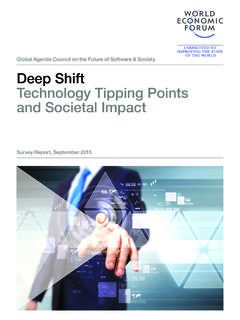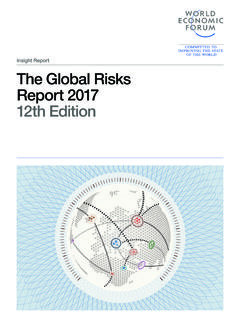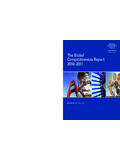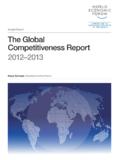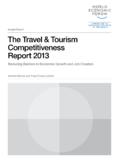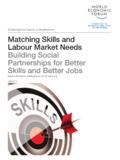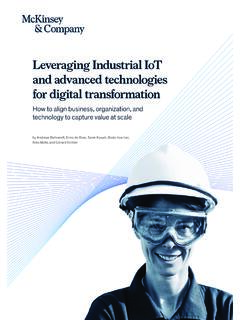Transcription of Insight Report The Future of Jobs Report 2018
1 The Future of jobs Report2018 Insight ReportCentre for the New Economy and SocietyInsight ReportThe Future of jobs Report2018 Centre for the New Economy and SocietyWorld Economic Forum91-93 route de la CapiteCH-1223 Cologny/GenevaSwitzerlandTel.: +41 (0)22 869 1212 Fax: +41 (0)22 786 2744E-mail: 2018 World Economic ForumAll rights part of this publication may be reproduced or transmitted in any form or by any means, including photocopying and recording, or by any information storage and retrieval 978-1-944835-18-7 TERMS OF USE AND DISCLAIMERThe Future of jobs Report 2018 (herein: Report ) presents information and data that were compiled and/or collected by the World Economic Forum (all information and data referred herein as Data ). Data in this Report is subject to change without terms country and nation as used in this Report do not in all cases refer to a territorial entity that is a state as understood by international law and practice.
2 The term covers well-defined, geographically self-contained economic areas that may not be states but for which statistical data are maintained on a separate and independent the World Economic Forum takes every reasonable step to ensure that the Data thus compiled and/or collected is accurately reflected in this Report , the World Economic Forum, its agents, officers, and employees: (i) provide the Data as is, as available and without warranty of any kind, either express or implied, including, without limitation, warranties of merchantability, fitness for a particular purpose and non-infringement; (ii) make no representations, express or implied, as to the accuracy of the Data contained in this Report or its suitability for any particular purpose; (iii) accept no liability for any use of the said Data or reliance placed on it, in particular, for any interpretation, decisions, or actions based on the Data in this parties may have ownership interests in some of the Data contained in this Report .
3 The World Economic Forum in no way represents or warrants that it owns or controls all rights in all Data, and the World Economic Forum will not be liable to users for any claims brought against users by third parties in connection with their use of any World Economic Forum, its agents, officers, and employees do not endorse or in any respect warrant any third-party products or services by virtue of any Data, material, or content referred to or included in this shall not infringe upon the integrity of the Data and in particular shall refrain from any act of alteration of the Data that intentionally affects its nature or accuracy. If the Data is materially transformed by the user, this must be stated explicitly along with the required source Data compiled by parties other than the World Economic Forum, users must refer to these parties terms of use, in particular concerning the attribution, distribution, and reproduction of the Data for which the World Economic Forum is the source (herein World Economic Forum ) is distributed or reproduced, it must appear accurately and be attributed to the World Economic Forum.
4 This source attribution requirement is attached to any use of Data, whether obtained directly from the World Economic Forum or from a who make World Economic Forum Data available to other users through any type of distribution or download environment agree to make reasonable efforts to communicate and promote compliance by their end users with these who intend to sell World Economic Forum Data as part of a database or as a standalone product must first obtain the permission from the World Economic Forum Centre for the New Economy and Society v Preface vii Key Findings 1 PART 1: PREPARING THE Future WORKFORCE 3 Introduction 6 Strategic Drivers of New Business Models 7 Workforce Trends and Strategies for the Fourth Industrial Revolution 15 The Future of jobs across Industries 17 The Future of jobs across Regions 19 A Look to the Recent Past (in Collaboration with LinkedIn) 22 Conclusions 25 References and Further Reading 27 Appendix A: Report Methodology 31 Appendix B: Industry and Regional Classifications 33 PART 2: INDUSTRY AND COUNTRY/REGION PROFILES 35 User s Guide.
5 How to Read the Industry and Country/Region Profiles 41 Industry Profiles 67 Country/Region Profiles 127 Contributors 129 System Initiative Partners 131 Survey Partners 133 AcknowledgementsContentsiiiPrefaceKLAUS SCHWABF ounder and Executive Chairman, World Economic ForumThe emerging contours of the new world of work in the Fourth Industrial Revolution are rapidly becoming a lived reality for millions of workers and companies around the world. The inherent opportunities for economic prosperity, societal progress and individual flourishing in this new world of work are enormous, yet depend crucially on the ability of all concerned stakeholders to instigate reform in education and training systems, labour market policies, business approaches to developing skills, employment arrangements and existing social contracts. Catalysing positive outcomes and a Future of good work for all will require bold leadership and an entrepreneurial spirit from businesses and governments, as well as an agile mindset of lifelong learning from fundamental pace of change has only accelerated further since the World Economic Forum published its initial Report on this new labour market The Future of jobs : Employment, Skills and Workforce Strategy for the Fourth Industrial Revolution in January 2016.
6 With an increased need for tangible evidence and reliable information from the frontlines of this change, this new edition of the Future of jobs Report once again taps into the collective knowledge of those who are best placed to observe the dynamics of workforces executives, especially Chief Human Resources Officers, of some of the world s largest employers by asking them to reflect on the latest employment, skills and human capital investment trends across industries and particular focus of this new edition of the Report is on arriving at a better understanding of the potential of new technologies, including automation and algorithms, to create new high-quality jobs and vastly improve the job quality and productivity of the existing work of human employees. As has been the case throughout economic history, such augmentation of existing jobs through technology is expected to create wholly new tasks from app development to piloting drones to remotely monitoring patient health to certified care workers opening up opportunities for an entirely new range of livelihoods for workers.
7 At the same time, however, it is also clear that the Fourth Industrial Revolution s wave of technological advancement is set to reduce the number of workers required for certain work tasks. Our analysis finds that increased demand for new roles will offset the decreasing demand for others. However, these net gains are not a foregone conclusion. They entail difficult transitions for millions of workers and the need for proactive investment in developing a new surge of agile learners and skilled talent prevent an undesirable lose-lose scenario technological change accompanied by talent shortages, mass unemployment and growing inequality it is critical that businesses take an active role in supporting their existing workforces through reskilling and upskilling, that individuals take a proactive approach to their own lifelong learning and that governments create an enabling environment, rapidly and creatively, to assist in these efforts. Our analysis indicates that, to date, many employers retraining and upskilling efforts remain focused on a narrow set of current highly-skilled, highly-valued employees.
8 However, in order to truly rise to the challenge of formulating a winning workforce strategy for the Fourth Industrial Revolution, businesses will need to recognize human capital investment as an asset rather than a liability. This is particularly imperative because there is a virtuous cycle between new technologies and upskilling. New technology adoption drives business growth, new job creation and augmentation of existing jobs , provided it can fully leverage the talents of a motivated and agile workforce who are equipped with futureproof skills to take advantage of new opportunities through continuous retraining and upskilling. Conversely, skills gaps both among workers and among an organization s senior leadership may significantly hamper new technology adoption and therefore business the World Economic Forum s Centre for the New Economy and Society, we provide a platform for leaders to understand current socio-economic transformations and shape a Future in which people are at the heart of economic growth and social progress.
9 A significant portion of our activities aim to support leaders in managing the Future of work. This biannual Report provides a five-year outlook based on the latest thinking inside companies and is designed to inform other businesses, governments and workers in their decision-making. Additionally the Centre is working across multiple industries to design sector-level vroadmaps to respond to the new opportunities and challenges of managing workforce transitions. The Centre is also supporting developed and emerging economies in setting up large-scale public private collaborations to close skills gaps and prepare for the Future of work. Finally, the Centre acts as a test bed for early-stage work at the frontier of managing the Future of work, ranging from the development of new principles for the gig economy to the adoption of common skills taxonomies across business and would like to express our appreciation to Vesselina Ratcheva, Data Lead, Centre for the New Economy and Society; Till Alexander Leopold, Project Lead, Centre for the New Economy and Society; and Saadia Zahidi, Head, Centre for the New Economy and Society for their leadership of this Report .
10 Additional thanks to Genesis Elhussein, Specialist, and Piyamit Bing Chomprasob, Project Lead, for their work on the Report s survey collection phase, and the support of other members of the Centre for the New Economy and Society team for its integration into a comprehensive platform for managing workforce change. We greatly appreciate, too, the innovative data collaboration with LinkedIn and the support of the Report s regional survey partners, which enhanced its geographical coverage. Finally, we continue to count on the proactive leadership of the Stewards and Partners of the System Initiative on Shaping the Future of Education, Gender and Work under the umbrella of the Forum s Centre for the New Economy and transformations are no longer an aspect of the distant Future . As shown in the five-year outlook of this Report , these transformations are a feature of today s workplaces and people s current livelihoods and are set to continue in the near term.
